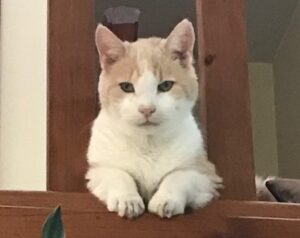The Vet Is In:
Aging Cats

Warning: Kitties can be addictive! Many clients tell me they have no intention of getting a new cat after the passing of their previous companion because they can’t face another heartbreak, yet they return later with a new feline with whom they are in love.
There is no magic way to prolong your beloved cat’s lifespan by estimating his/her age based on dentition and bone growth, but by diagnosing health/weight/hormonal problems early and feeding your cat appropriately, you can better your odds of having a long relationship with your new friend.
Cat Years Compared to Human Years
While aging, cats mature very rapidly initially, then slow down by their 3rd year, equivalent to approximately 29 years old for a human. At one year of age, your cat is the equivalent of 14.5 human years and able to reproduce (one reason spay/neuter is essential by now), at 10, he/she is equivalent to 57 human years, and at 17 years, he/she is 85. Your cat should have a physical and oral exam with your veterinarian yearly, increasing to twice annually once he/she is ten years of age or older.
Senior Cats Should Be Examined by a Veterinarian Twice Per Year
Because cats evolved to be superb at hiding symptoms of illness, trauma, and organ damage, these senior exams are essential. You should become adept at reporting signs of kidney failure or infection with abnormally excessive thirst and urine production; diabetes with its excessive weight drop, drinking, and urination; also hyperthyroidism with its rapid heart rate, increased appetite, and dramatic weight loss. Watch your elderly kitty’s gait: as his/her joints become stiffer, there may be lameness, but often the patient does not show a limp, but rather is simply less flexible in the limbs and slower.
With two annual visits for the geriatric kitty, your veterinarian can detect abnormal health concerns more rapidly and initiate treatment ASAP, whether it be weight loss for the diabetic cat, prescription diets for intestinal, kidney, or GI diets, or joint support for the early arthritic patient. With the earlier detection and treatment of problems, the better the chances are for improvement in your kitty’s health in the sunset years.
Make the Right Decision for Your Cat at the End
Please note: When your cat’s age and diagnosis indicate that he/she has come to the end of the line, some owners give “palliative care” in order to keep the patient comfortable at home while the body fails. Such care includes fluid therapy daily, syringe-feeding liquefied baby food, administering pain medications as needed, keeping the cat’s coat gently brushed or clipped to prevent the build-up of painful mats, and always being aware of the quality of life. Be strong and loving enough to let your veterinarian end your cat’s life before his/her condition declines sufficiently to create suffering.

If the patient is brought to the veterinarian exhibiting minimal responses, anorexia, dulled awareness, and severe dehydration, then, sadly, they have gone well beyond palliative care, and suffering has been introduced (inadvertently) into the final goodbye.The separation becomes painful, not peaceful. Please listen to your veterinarian who may recognize your companion’s suffering when you are not yet ready to do so. And of course, never place your cat is a so-called hospice or shelter outside your home, when familiar family and surroundings are crucial to a gentle passing.
Dr. Holly Cheever, DVM
Enjoy your new friend!
NYSHA’s VP, Dr. Holly Cheever, is a partner in a small animal practice, the Village Animal Clinic, in Voorheesville, NY. She sits on several boards for animal issues, is a speaker and consultant across the nation, and has testified before Congress about animal abuse in circuses, as well as in New York City regarding the carriage horse trade.
New York State Humane Association Humane Review, Vol.XXXIX, Spring 2022.